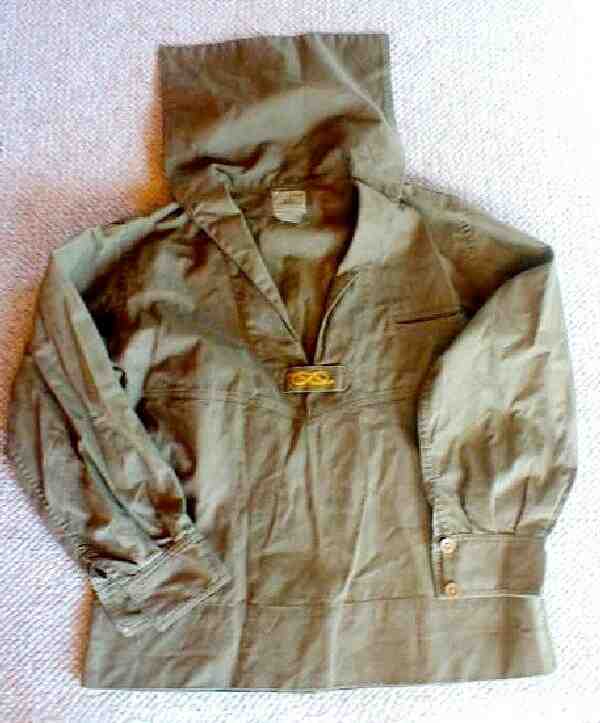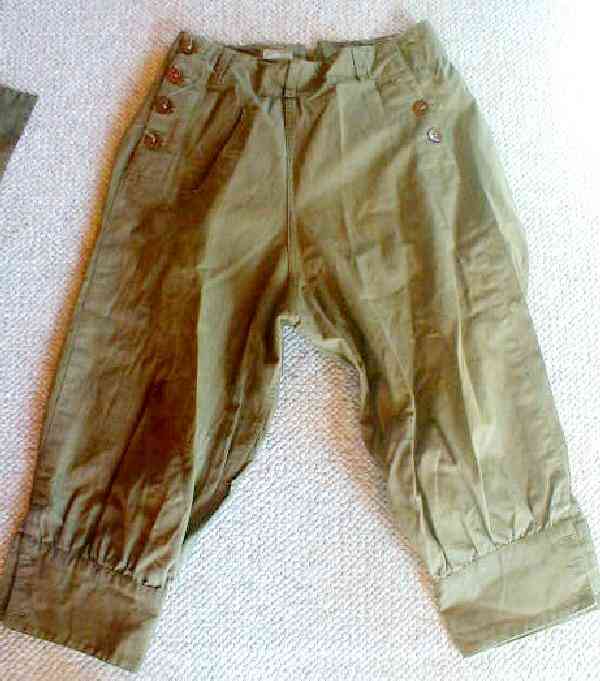
Unknown Images: Image 4--Vintage Uniform

Figure 1.--This poncho garment looks to be part of a youth group uniform. The square backflap I believe is a hood. I'm not sure about the the yellow badge in front. I thought this might be an American Boy Scout uniform garment, but do not recall seeing Scouts wearing them. Click on the image to see the label.
|
A reader has sent HBC some images of a uniform she plans to sell as vintage clothes on E-bay. She wants to know if we can identify the youth group. We were confused by the garments which consisted of a poncho-type jacket and knicker pants. The label was in English. We are guessing it might be American because of the knicker pants, but there are a variety of problems in identifying the uniform. We thought it might be a Boy Scout unifotm because of the color and the knicker pants. The fact that it is a size 10, however, means tht it was not a Boy Scout uniform. The ebtry age for American Scouting until 1949 was 12 years. This was changed to 11 in 1949, but at this time knickers had been dropped from the program which means that American Boy Scout knickers were not made in size 10. Boys age 10 could participare in Cubs, but Cubs uniforms were a destinctive blue.
Vintage Clothing
A reader has sent HBC some images of a uniform she plans to sell as vintage clothes on E-bay. She wants to know if we can identify the youth group. These vintage clothing pages are interesting as they provide color information usually unavailable in the photographic befotre the 1970s. Thry often provide labels and close up of details such as buttons and pockets as well as other features.
Garments
We were confused by the garments which consisted of a poncho-type jacket and knicker pants. Unfortunately the shirt is not available. The shirt is often the most recognizable artile of youth group clothing. It is particularly useful because the awards and badges were usually sewn on the shirt. The first garment here looks like a poncho (figure 1). It looks to have a hood. A reader writes, "
Are you sure that's a hood? Looks like an attenuated version of the back flap of a middy blouse. The embroidered knot design looks kind of nautical." HBU diesn't think the Boy Scouts would have a poncho with a middy blouse back flap. The owner tells, us, however, that it is just a flap. We found this rather surprising. Is it possible that the Sea Scouts at first had regular green Scout uniforms? The pants look like they don't have a fly, which would mean that those buttons
on the side are one half of a fall front opening. Are there two buttons missing from the other side? I don't recall American Scouts having a poncho like the one here, but am not sure about this. The knickers do look like the knickers worn by American Scouts. The knickers have an elaborate buttoning arangement. A reader writes, "The pants look like they don't have a fly, which would mean that those buttons
on the side are one half of a fall front opening. Are there two buttons missing from the other side?" Yes as this was a vintage garment, buttons appear to be missing. I'm not sure when the Scouts replaced byttons with zippers on their pants, but believe it was in the 1950s. The label was in English. The fact that both are in the same color and have the same label is a strong indication that they are a youth group uniform. A British reader writes, "I noted your coments about not understanding the buttons being by the side. I remember I once had a pair of grey shorts that did that. It seemed strange having to button them up at the side rather than the fly. I notice from the picture that the fly is missing from the knickers. The shorts I've just mentioned did have a fly."
Chronology
We are unsure about the chronology of the uniform. The use of buttons and the fact that the pants are knickers suggests that the garments date before the 1940s. American Scouts wore knickers, but they were discontinued in 1942.
Manufacturer
The brand name was "Man O' War". We are unsure about the name of the company. The label seems to read, Branigan, Green & Co. which was located in Baltimore, Maryland. Branigan, Green & Co are listed in the 1930 New York City Classified Business Directory as a manufacturer of children's and infant's clothing. They had a office at 1270 Broadway
in New York City.

Figure 2.--The knickers and the color lead us to believe that the uniform was avAmerican Boy Scout uniform. The size 10, however, suggests that this may not be the case as the entry age was 12 years old. I donunderstand all the buttons at the side,
|
Country
We guessed the uniform was American because of the knicker pants. The American Boy Scouts through the 1930s worke knickers while Scouts from other countries wore short pants. The bel confirms that the uniform is American. There are a variety of problems, however, in identifying the uniform.
The Scouting movement was founded by Lord Baden-Powell in England. Americans and boys' organizations played a major role in the movement. The Scouting movement was simply accepted in many countries. American played a major role in the program that was finally conceived by Baden-Powell. When American Scouting was founded, existing organizations were incoroprated into it. Despite this role in the Scouting movement, American Scouts dd not follow the unifiorm conceived by Baden-Powell and adopted by virtually every other country. American Scouts insisted on wearing knickers rather than short pants.
Color
The color of these garments does look like the color od the American Scout uniforms. Here the color varied over time, but until 1981 was always olive green or some other shade of green.
Assessment
We thought it might be a Boy Scout unifotm because of the color and the knicker pants. The fact that it is a size 10, however, means that it was not a Boy Scout uniform--if in fact it was a size 10 garment. We are not sure just what size 10 meant, but the most likely interpretation was that it was sized for a boy 10 years old. The entry age for American Scouting until 1949 was 12 years. This was changed to 11 in 1949, but at this time knickers had been dropped from the program which means that American Boy Scout knickers were not made in size 10. Boys age 10 could participare in Cubs, but Cubs uniforms were a destinctive blue.
Reader Comment
An Australian reader tells us, "Regarding the unknown knickerbocker uniform with the rectangular flap at the back of the shirt (which you think may be a hood); to me it seems to have a naval design but that is just a guess. However the badge at the front of the shirt is definitely an Australian/UK Scout Leaders long service badge. It is possible the badge may have been added by a wearer at a later date or the uniform may have belonged to some Sea Scout Group." [Muir]
Sources
Muir, John. E-mail message, October 14, 2005.
HBU

Navigate the Historic Boys' Uniform Web Site:
[Main unknown image page]
[Activities]
[Biographies]
[Chronologies]
[Countries]
[Essays]
[Garments]
[Organizations]
[Religion]
[Other]
[Introduction]
[Bibliographies]
[Contributions]
[FAQs]
[Questions]
[Boys' Uniform Home]
Navigate the Historic Boys' Uniform Web chronological pages:
[1900s]
[1910s]
[1920s]
[1930s]
[1940s]
[1950s]
[1960s]
[1970s]
[1980s]
[1990s]
Navigate the Historic Boys' Clothing Web Organization pages:
[Boys' Brigade]
[Boy Scouts]
[Camp Fire]
[Royal Rangers]
[Hitler Youth]
[Pioneers]
[Youth groups]
[HBU Home]
Created: 3:02 PM 10/7/2004
Last updated: 1:41 AM 10/14/2005




